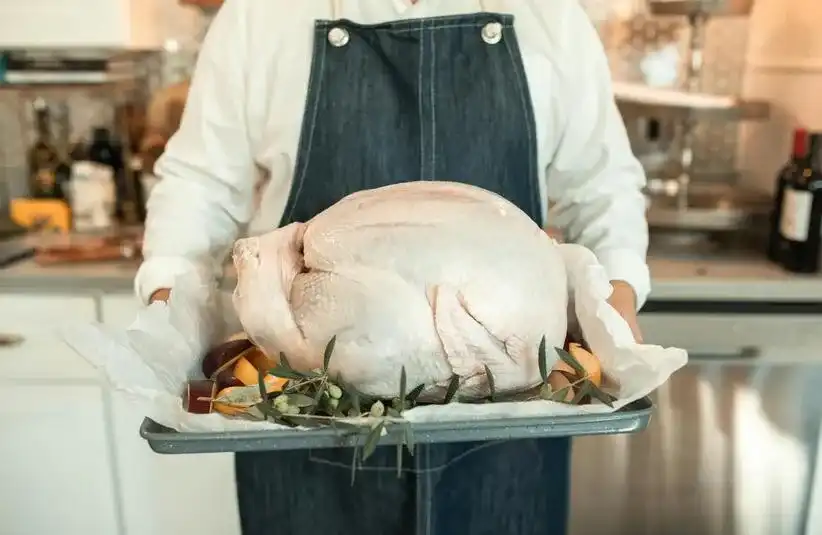What to Do If Your Turkey’s Still Frozen on Thanksgiving Morning
Okay, don’t panic. You’ve checked on the star of the show, the golden-brown centerpiece of your Thanksgiving feast, only to find it’s less “ready for its close-up” and more “cryogenically frozen artifact.” Your turkey is FROZEN! The guests are arriving in a few hours, the oven is preheating, and your main course is a ten-pound glacier. This is fine. Everything is fine. After researching and preparing side dishes, calculating cooking times, and figuring out how much your kitchen can handle, this is still one giant issue that will not take down your Thanksgiving meal.
Before you think that you will be serving your guests a feast of mashed potatoes, mac-n-cheese and greens, let’s go over the game plan to save the bird. We can fix this. Probably.
Emergency Thawing Protocols: Operation Defrost

Emergency thawing protocols take place when the ideal refrigerator thaw of about 24 hours for every four to five pounds is no longer plausible. That ship has sailed, hit an iceberg, and sunk to the bottom of your very cold fridge. It’s time to initiate the emergency, last-minute, please-let-this-work thawing methods. According to the food safety wizards at the USDA, you have a couple of viable options.
Method 1: The Cold Water Bath
This is your most reliable quick-thaw technique. Find a container (or a thoroughly cleaned sink) large enough to fully submerge the turkey. Keep the bird in its original, leak-proof packaging and place it in the cold water. Here’s the critical part: you must change the water every 30 minutes. This isn’t a suggestion; it’s a rule. You need to keep the water cold to prevent the main centerpiece from entering the “danger zone” where bacteria throw a party you definitely don’t want to attend. The rule of thumb is around 30 minutes of thawing time per pound.
So, for a 16-pound bird, you’re looking at a commitment of about eight hours. Yes, that means an early start, but it’s better than the alternative. Once it’s thawed, you must cook it immediately! No breaks.
Method 2: The Microwave Gambit
This is a high-risk, high-reward maneuver. First, check if it even fits in the microwave. If it does, consult your microwave’s manual for specific instructions on power levels and time per pound. As a general guideline, plan for about six minutes per pound on the defrost setting. You’ll need to remove all the wrapping and place the turkey on a microwave-safe dish. Make sure to rotate and flip the bird several times during the process to ensure it thaws evenly. Like the cold water method, a microwaved turkey needs to be cooked immediately after thawing.
Plan B: Cooking From a Frozen State
What if you don’t have time for any of that? What if your bird is still a stubborn ice-brick when it’s time to cook? Good news! You can actually cook a turkey from a frozen or partially frozen state. The catch? It will take at least 50% longer to cook than a fully thawed bird. Set your oven to 325°F and brace yourself for a longer bake time. A 12- to 14-pound frozen turkey could take around 4.5 to 5.75 hours to cook. The giblet packet might be frozen inside; you can usually pull it out with tongs after the turkey has been cooking for about 30 minutes.
The most important tool in this scenario is a food thermometer. Your turkey is safe to eat only when it reaches an internal temperature of 165°F in three places: the innermost part of the thigh, the innermost part of the wing, and the thickest part of the breast. Do not skip this step.
When All Else Fails: Hail Mary
There comes a time when we must all admit defeat. If you look at that turkey, and you know in your heart of hearts it will not work, do not worry too much. Pull out your playbook of alternative strategies.
- Cook Turkey Parts: Instead of a whole bird, you can roast breasts, thighs, or wings. They cook much faster and are easier to manage. A 4- to 8-pound whole breast, for example, might only take 1.5 to 3.25 hours.
- Spatchcock It: If it is thawed enough to handle, you can spatchcock it. Spatchcocking means cutting out the backbone of the bird so that it will lie flat. This will allow the turkey to cook more quickly and more evenly.
- Embrace Other Poultry: A whole chicken, duck, or a few Cornish game hens can save the day. They offer that festive poultry vibe with a fraction of the cooking time.
- The Store-Bought Save: There is zero shame in buying a pre-cooked rotisserie chicken or a complete Thanksgiving meal from your local grocery store. Just make sure to keep hot foods hot (above 140°F) until it’s time to serve.
Final Thoughts: Food Science
Look, a frozen turkey on Thanksgiving morning feels like a disaster. It’s the kind of problem that sends a little jolt of panic straight to your heart. But it’s not the end of the world. With a little food science and a calm-ish head, you can still pull off a fantastic meal. Whether you’re attempting a frantic cold water thaw, bravely cooking a frozen turkey, or making a strategic retreat to the grocery store, you have options. The goal is to get delicious, safely-cooked food on the table and enjoy the day with people you care about. If things don’t go perfectly, you’ll have a great story to tell next year.







